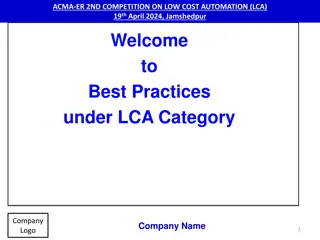
What is HR Automation Top HR Automation Tools in 2024
HR automation refers to the use of software and technology to streamline and manage human resources tasks. Automated HR processes replace manual and repetitive tasks, enhancing efficiency and accuracy.
Download Presentation

Please find below an Image/Link to download the presentation.
The content on the website is provided AS IS for your information and personal use only. It may not be sold, licensed, or shared on other websites without obtaining consent from the author. Download presentation by click this link. If you encounter any issues during the download, it is possible that the publisher has removed the file from their server.
E N D
Presentation Transcript
What is HR Automation? Top HR Automation Tools in 2024 HR automation refers to the use of software and technology to streamline and manage human resources tasks. Automated HR processes replace manual and repetitive tasks, enhancing efficiency and accuracy. Automated systems can handle various functions:
Recruitment: posting job openings, reviewing applications, and setting up interviews. Onboarding: Document collection, training sessions, and orientation. Payroll: Calculating salaries, deductions, and generating payslips. Performance Management: Tracking employee performance and feedback. Employee Self-Service: Allowing employees to update personal information and submit requests. By leveraging automation, HR professionals can focus on strategic functions, fostering a more productive work environment. Why HR Automation Matters in 2024 HR automation is pivotal in 2024 for several reasons: Efficiency: Automation minimizes manual errors and accelerates HR processes. Cost Savings: Reduces the need for extensive HR personnel, cutting costs. Data Management: Allows for better data organization and analytics. Compliance: assures compliance with dynamic labor laws and regulations. Employee Experience: Streamlines onboarding, payroll, and benefits management, improving satisfaction. Scalability: Supports growth without a significant increase in HR overhead. Talent Management: Enhances recruitment processes through automated screening and onboarding. Important Qualities of HR Automation Tools
HR automation tools can greatly enhance operational efficiency in managing human resources. When selecting an HR automation tool, consider the following key features: User-friendly Interface: An intuitive and easy-to-navigate interface. Integration Capabilities: Seamless integration with existing systems like payroll, attendance, and performance management software. Customizability: Flexibility to adapt workflows and processes according to the company s needs. Scalability: Ability to grow and evolve within the organization. Data Security: strong security protocols to safeguard private employee data. Reporting and Analytics: Comprehensive analytics and reporting features to track key HR metrics. Mobile Accessibility: Mobile app support for on-the-go access. Compliance Management: Tools to ensure compliance with legal and regulatory requirements. Employee Self-service: Features that let staff members freely manage their jobs and information. Top Trends in HR Automation for 2024 As the HR landscape continues to evolve, several key trends are emerging for 2024: AI and Machine Learning: Enhanced use of AI for predictive analytics in hiring and employee performance. Employee Self-Service Platforms: Increased adoption of platforms allowing employees to manage their HR tasks. Integration with Existing Systems: Seamless integration of HR automation tools with current enterprise systems. Remote Workforce Management: Tools designed to better manage and engage remote employees. Advanced Data Security: Heightened focus on data protection and compliance.
Workflow Automation: Streamlined processes through sophisticated automation solutions. Criteria for Evaluating HR Automation Tools When assessing HR automation tools, organizations should consider various factors to ensure optimal performance and alignment with business goals. 1. Integration Capabilities: How seamlessly the tool integrates with existing HR systems like payroll, timekeeping, and benefits management. 2. User Interface and Experience: The ease of use and accessibility for both HR professionals and employees. 3. Scalability: The tool s ability to grow with the organization, accommodating future expansion and increased HR demands. 4. Data Security: Strong security protocols to safeguard private employee data. 5. Customer Support: The accessibility and caliber of vendor assistance for direction and troubleshooting. 6. Cost: Total cost of ownership, including licensing fees, implementation, and maintenance. Comprehensive Employee Management Platforms Entire employee lifecycle management is possible with comprehensive employee management platforms, which offer end-to-end HR solutions. These platforms streamline recruitment, onboarding, performance management, and offboarding processes. Key features include: Recruitment Management: Automated job postings. Applicant tracking system (ATS).
Onboarding: Digital document signing. Training modules. Performance Management: Goal setting. 360-degree feedback. Payroll and Benefits: Automated payroll processing. Benefits administration. Employee Self-Service: Personal data management. Access to pay slips and tax forms. These tools ensure compliance and enhance employee engagement. 1. Advanced Payroll and Benefits Systems Modern HR automation includes advanced payroll and benefits systems. These tools streamline payroll calculations, tax compliance, and benefits administration. Advantages include: Accuracy: Reduces human errors in wage calculations and tax filings. Efficiency: reduces labor-intensive work and frees up HR time. Compliance: Ensures adherence to changing labor laws and tax regulations. Employee Satisfaction: Provides employees with quick access to payroll and benefits information. Key Features: 1. Automated Calculations: Real-time payroll processing. 2. Tax Management: Automatic tax deductions and updates.
3. Benefits Administration: Seamless integration with health and retirement plans. 4. Reporting Tools: Comprehensive reports for financial and compliance auditing. 2. Recruiting and Onboarding Solutions Automation in recruiting and onboarding streamlines time-consuming processes: Applicant Tracking Systems (ATS): Simplifies job posting, resume filtering, and candidate tracking. AI-Powered Screening: Utilizes algorithms to assess resumes, reducing human bias. Onboarding Portals: Centralizes paperwork, training, and orientation. Interview Scheduling: Automates calendar invites and reminders. Workflow Management: Ensures consistent, compliant onboarding procedures. Feedback Mechanisms: Collects candidate and new hire feedback for continuous improvement. By integrating these tools, HR departments can enhance efficiency, improve candidate experiences, and ensure smoother transitions for new hires. 3. Employee Performance Management Software Employee Performance Management Software streamlines the evaluation and development of employees. These systems offer: Objective Tracking: Align employee objectives with company goals. Continuous Feedback: Encourage constant contact between management and staff.
Performance Reviews: Automate the review process with customizable templates. Skill Gap Analysis: Identify and address training needs. Reporting and Analytics: Provide insights into performance trends. These features enhance productivity and ensure a data-driven approach to employee development. By integrating performance management with other HR functions, organizations can foster a culture of continuous improvement and accountability. 4. Learning and Development Systems Systems for learning and development are essential for promoting staff development. These systems assist HR departments in managing and delivering effective training programs. Key features include: Automated Training Schedules: Streamlines planning and ensures timely course delivery. Progress Tracking: Monitors employee performance and competency development. Personalized Learning Paths: Tailors training modules to individual needs based on job roles. Compliance Management: Guarantees compliance with industry rules and guidelines. Reporting and Analytics: Provide insights into training effectiveness and return on investment (ROI). Learning and Development Systems optimize skill enhancement and contribute to organizational growth. 5. Employee Self-Service Portals Employee self-service (ESS) portals empower employees and enhance HR efficiency. ESS portals provide a centralized platform for employees to access and manage their information. Key features include:
Personal Information Management: Employees can update their contact details, emergency contacts, and personal data. Leave and Attendance: Request leaves of absence and verify the amount of time you have left. Payroll and Benefits: Access pay stubs, tax documents, and benefits information. Training and Development: Enroll in courses and track progress on learning programs. Company Policies and Announcements: Stay informed with easy access to policies and corporate communications. ESS portals reduce administrative burden, enhance user experience, and improve data accuracy. 6. Integrated Time and Attendance Systems Integrated Time and Attendance Systems streamline the process of tracking employee hours and managing attendance. These systems are essential for automating timekeeping, reducing errors, and ensuring compliance with labor laws. Automated Time Tracking: Automatically records employee in/out times. Compliance: Aids in fulfilling the legal obligations for recording attendance. Payroll Integration: Synchronizes with payroll systems for accurate payment. Real-Time Analytics: Provides immediate access to attendance data. Customizable Alerts: Sends notifications for attendance anomalies. Mobile Access: Enables mobile device clock-in and clock-out for employees. Reporting: Generates detailed attendance reports for management.
By leveraging these features, organizations can improve efficiency and accuracy in time and attendance management. 7. Compliance Management Tools Tools for compliance management make sure businesses follow internal and regulatory guidelines. These solutions offer: Automated Audits: Regular, systematic reviews are automated, reducing manual errors. Policy Updates: Tools maintain HR policies current with the most recent legal mandates. Reporting Capabilities: Generate comprehensive compliance reports effortlessly. Training Modules: Automated training programs maintain staff awareness and understanding of compliance. Document Control: Secure storage and easy retrieval of compliance-related documents. HR departments leverage these tools to minimize risks associated with non-compliance, ensuring a smooth, legally sound operation. 8. HR Analytics and Reporting Solutions HR Analytics and Reporting Solutions offer advanced tools to analyze workforce data, helping organizations make data-driven decisions. These tools: Track employee performance and engagement levels Provide insights into recruitment effectiveness Measure the impact of training programs Monitor turnover rates and retention strategies
Such solutions integrate with existing HR systems, ensuring seamless data flow and updating. These tools also support predictive analytics, enabling HR professionals to foresee trends and prepare actionable strategies. Enhanced reporting capabilities allow for customized, real-time reports and dashboards, promoting transparency and informed decision-making. 9. Artificial Intelligence in HR Automation Artificial Intelligence (AI) has revolutionized HR automation by streamlining processes and enhancing decision-making. Key applications include: Recruitment: AI sets up interviews, reviews resumes, and matches applicants to job descriptions. Employee Onboarding: Automated chatbots provide new hires with essential onboarding information and training modules. Performance Management: AI-powered solutions use analytics and predictive insights to assess worker performance. Employee Engagement: Sentiment analysis tools gauge employee satisfaction and suggest improvements. Payroll Automation: AI ensures timely and accurate payroll processing by managing time and attendance data. Compliance: Automated compliance monitoring systems reduce risk by ensuring adherence to regulatory requirements. Overall, AI significantly optimizes HR functions. 10. The Future of HR Automation The future of HR automation promises significant advancements in efficiency and employee engagement. Key trends shaping the future include:
Artificial Intelligence Integration: Leveraging AI to enhance recruitment, performance reviews, and employee sentiment analysis. Predictive Analytics: Utilizing data to forecast hiring needs, turnover rates, and workforce planning. Employee Self-Service: Expanding access to automated self-service portals for routine HR requests. Blockchain: Ensuring secure and transparent verification of credentials and work history. Remote Work Management: Automating compliance and performance tracking for remote teams. These trends indicate a shift towards more intelligent, data-driven HR processes. Challenges and Considerations When Implementing HR Automation HR automation presents a number of issues and concerns that businesses need to take into account: Data Security: Ensuring sensitive employee information remains confidential. Integration Issues: Smoothly merging automation tools with existing HR systems. Employee Resistance: Overcoming reluctance to adopt new technologies. Cost Concerns: Evaluating the financial investment required. Customization Needs: Tailoring solutions to fit specific organizational requirements. Legal Compliance: Respecting labor laws and rules. Training Requirements: Providing adequate training for HR staff to use new systems. Change Management: directing the switch to automated procedures with effectiveness.
How to Pick Your Organizations Best HR Automation Tool Identifying the best HR automation tool requires assessing the distinct needs of your organization. Key factors include: 1. Scalability: Make sure the tool expands with your business. 2. Integration: Check for compatibility with existing systems. 3. User-Friendliness: The interface should be easy for all staff. 4. Customization: Ability to tailor features to organizational requirements. 5. Vendor Support: Reliable customer service and training. 6. Data Security: Strong security protocols to safeguard private data. 7. Cost: Balance between affordability and feature set. Collect feedback from stakeholders to make an informed decision. HR Automation s Effect on Contemporary Workplaces HR automation revolutionizes modern workplaces by streamlining administrative tasks, enhancing employee experience, and improving data accuracy. Key impacts include: Increased Efficiency: HR personnel may concentrate on key goals by automating repetitive processes. Cost Reduction: Reducing manual labor costs and minimizing errors lead to financial savings. Improved Compliance: Automation ensures adherence to legal regulations and company policies. Enhanced Employee Engagement: Timely responses to employee queries boost satisfaction.
Data-Driven Decisions: Accurate data collection facilitates informed decision-making. In sum, HR automation is essential for maintaining competitive advantage in today s rapidly evolving business environment.






















